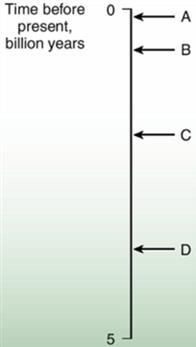Urban is defined by the U.S. Census Bureau as ________
A) areas where patches of commercial and residential developments are interspersed in a matrix of rural land
B) a large central city and adjacent communities
C) the parts of a metropolitan area located outside the central city
D) an area where the average population density is at least 500 people per square mile
E) an area with more than 10 million inhabitants
D
You might also like to view...
Carefully examine the relative positions of the lettered arrows in the diagram. Which letter corresponds most closely to the extinction of the dinosaurs?

As soils mature, distinct layers called ________ appear.
A. layers B. units C. strata D. horizons E. beds
Why are seasonal changes less noticeable near the equator than at mid-latitudes?
What will be an ideal response?
Which of the following accurately describes 18O/16O ratios of the world's oceans?
A) Neither the 16O or 18O isotopes are common in water, so when either is present, it shows a disequilibrium in normal climatic conditions. B) The 16O/18O ratio is low during colder temperatures because temperatures are too low for evaporation to be effective and both isotopes remain in the ocean. C) Because 18O evaporates more readily than 16O, the oceans have a higher relative abundance of 16O during warm periods and a more balanced ratio when evaporation is less. D) During periods of colder temperature 16O is locked up in snow and ice and the oceans have a higher preponderance of 18O; during warmer periods the isotope ratio of 16O to 18Ois higher. E) The higher the ratio of oceanic 16O to 18O, the colder the temperatures because the 18O will have been mostly evaporated from ocean waters.